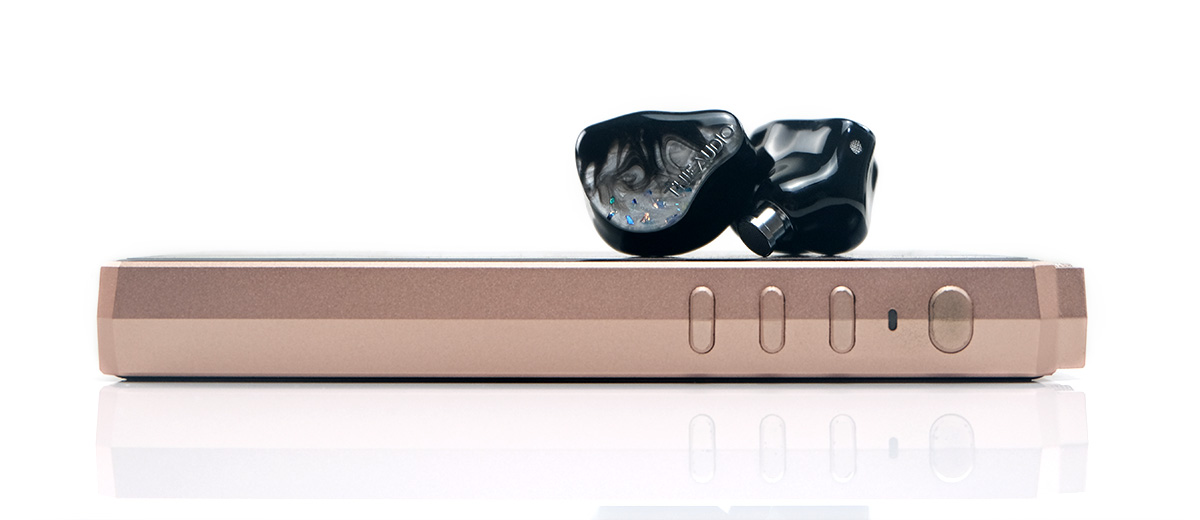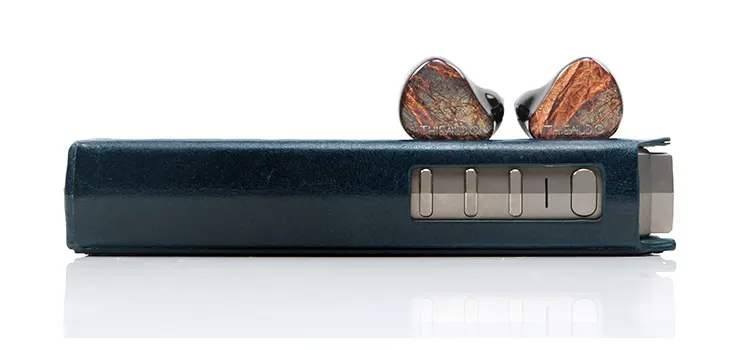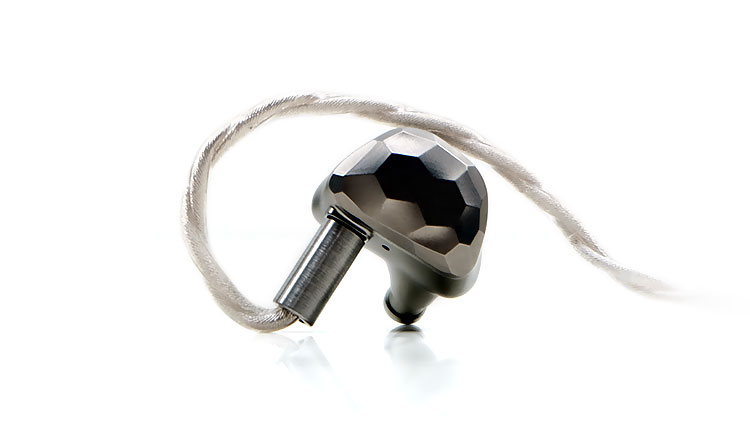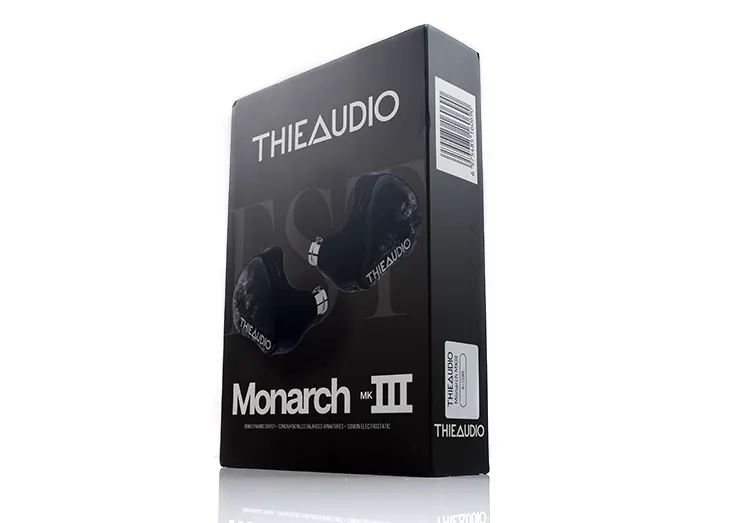Select Comparisons
The following comparisons to the Monarch MKIII were completed using a mix of the iBasso DX320 with AMP12, and the HiBy RS6 as our main sources. All compared monitors were fitted with their stock tips and balanced 4.4mm terminated cables.
THIEAUDIO Monarch MKII
The very well-received second-generation THIEAUDIO Monarch MKII was launched sometime around late 2021 or early 2022 depending on where you lived. It is still being sold by Linsoul for the same price as the Monarch MKIII.
Technical
Both monitors are tribrid multi-drive driver universal monitors. This means a mix of dynamic, BA, and electrostatic drivers in dual-module arrays with the big difference being the change to the dual dynamic drive isobaric configuration, (IMPACT2), in the Monarch MKIII.
The MKII uses the same type of 10mm composite diaphragm driver but only 1 driver as opposed to 2 in a regular configuration making it a 9-driver model as opposed to 10 in the MKIII.
There are some other subtle changes to the rest of the driver makeup including a re-tuning of the EST drivers for better upper treble extension and presence as well as an improvement in the mids BA driver’s separation and coherency.
The sensitivity levels have changed a bit from the MKII with the Monarch MKIII rated with a lower impedance of 20Ω as opposed to 36Ω but with a significant sensitivity drop on paper going from
108dB/ mW to 99dB @ 1kHz (+/- 1dB).
In truth, you have nothing to worry about with the rated drop in sensitivity from the Monarch MKIII. It is the more sensitive of the two monitors by a few dB using the DX320/AMP12’s balanced output in low gain.
I suspect THIEAUDIO’s measurement weighting system for SPL has changed from the MKII to bring about that initially misleading set of ratings.
Design
I agree with most anecdotal comments I have seen that the Monarch MKIII is bigger than the MKII but I also believe the contouring is much better on the MKIII shells. That allows for a subtle enhancement in how secure the MKIII fits in my ear compared to the blander curves of the MKII.
Does that enhance isolation? Not really, both isolate to the same level which is on par with most vented dynamic driver hybrids and not on the same level as a sealed all-BA shell. However, I honestly find them both very comfortable with the stock silicone tips which are the same type for both monitors.
You will get some improved isolation and a stronger seal with the stock foam tips on both monitors but at the cost of some enhanced ear canal pressure when inserted which is not to my liking.
The design language between both is very similar for the default shells. It is a case of personal preference between the amber faux wood tones of the MKII or the more aquatic-flavored sparkle and white swirl of the MKIII.
The key difference is the Monarch MKIII’s customizable options for an additional $100 which can give you a lot more design options whereas the MKII does not seem to come with the same custom choices.
The cable has also been upgraded on the Monarch MKIII with a switch from copper to SPC and a larger 22AWG as opposed to 26AWG wire inside. The twisted PVC finishing on the outside gives it a lower profile compared to the more microphonic nylon braiding of the MKII cable.
Both have interconnects but the barrels on the MKIII are smaller, lighter, and work better for tightly spaced output sockets on some sources such as iBasso’s 2.5mm-equipped amp cards.
Performance
You can tell right away the Monarch MKIII is more or less the MKII on ‘steroids’. THIEAUDIO has tweaked some areas to produce a more dynamic and cleaner tuning.
You get an enhanced mid-bass presence and more ‘fill’ in the upper mids to better capture what seems to be a more energetic upper-treble presentation.
Most would argue that the MKII is fairly well-balanced and comes close to the ideal Harman Target Response curve for IEMs. It has lifted sub-to-mid-bass from 50Hz right up to the lower-mids that inject a bit of warmth and a similar pinna gain amplitude at around 2-3k to balance it out.
The Monarch MKIII ups the 50Hz to 200Hz range to enhance the body and punch with just a shade more sub-bass presence. It also has a bit less gain from 2-3k but has a more linear curve from 4-8k, with fewer drops compared to the MKII over this region, and more upper-treble extension.
The result is a more dynamic and roomier sound signature, with more contrast and sparkle in the timbre and enhanced presence through the upper-mids onwards. The mid-timbre is slightly less liquid, perhaps arguably more accurate as a result, but those mids also come with more space and better separation.
You also get a punchier and more aggressive bass response through to the lower-mids, retaining some warmth from the MKII but more upper-mids and treble presence giving female vocals a bit more energy in the process.
I would still say the MKII is generally smoother across the FR. Its liquid-like tones in the mids tend to be more forgiving for peaky bright mixes. However, if you want enhanced clarity, a taller soundstage, and more power, then the Monarch MKIII is the right pick.
Unique Melody MEXT
The Unique Melody MEXT was launched in early 2022 and is now very close in price to the Monarch MKIII for the universal version and a slightly higher price point for the custom alternative. You can read our full review of the MEXT here.
Technical
The MEXT is a hybrid multi-driver monitor though arguably with the inclusion of bone conduction drivers, you could call it a tribrid. Like the Monarch MKIII, you get a mix of BA and dynamic but there are no electrostatic drivers in the MEXT.
It also uses only one 10mm dynamic driver model so nothing with a claimed isobaric configuration like the dual driver IMPACT2 system inside the Monarch MKIII.
The precise configuration of the MEXT is a single 10mm dynamic driver for the lows and four balanced armature drivers with 2 for the mids and 2 for the highs using a 4-way crossover.
The OBC or “Original Bone Conduction” ‘driver’ is more of a layer over mainly the lows to the mids to give the overall performance a more tactile feel in your ear.
The Unique Melody MEXT is rated at 16Ω and 108 dB @1kHz SPL which is similar is a little lighter in impedance compared to the Monarch MKIII but at this level, it will not make a huge difference.
The SPL, however, does with the Monarch MKIII rated 9 dB less efficient at 99 dB @ 1kHz (+/- 1dB). Indeed, you can pick that difference up with both connected to a DX320/AMP12 balanced output in low gain with the MEXT needing less dB to volume match.
Design
Unlike the Monarch MKIII, the MEXT comes in both universal and custom formats. However, the MKIII goes some way to addressing that with its shell and plate customization options which can bring a dash of color and uniqueness to its visual presentation.
Still, the shape and design are fixed whereas the MEXT custom format we have here is 100% molded for my ears only. You pay more for that but for some the precise fit will be worth it for the improved level of isolation and a more secure fit.
It should be worth noting that those complaining about the Monarch MKIII’s slightly large shell should take a moment to compare it to the custom MEXT which is much bigger. Customs tend to always be bigger than most universals given they have to pretty much fill your entire ear for them to seal properly.
I do think the Monarch MKIII stock cable is a better cable than the UM Copper M1 that comes with the MEXT. Quite apart from the fact it has interchangeable sockets, the Monoarach MKIII stock cable has a supplier build to it so it handles better during daily use.
The Copper M1 is also a smaller 26AWG gauge OFHC copper 4-wire geometry whereas the MKIII stock cable is a lower resistance 22AWG 6N OCC silver-plated and graphene silver-plated wire.
Performance
The MEXT is darker sounding, less airy, with a higher or longer bass shelf, and more neutral through the midrange.
The Monarch MKIII has the better headroom with those EST drivers creating an airier quality to the presentation which the MEXT lacks. It will sound comparatively leaner to the MEXT through the mids, less rounded in its note timbre with more contrast in its coloration.
Much of that comes from the MKIII’s lifted 2-5k range which is further forward than the MEXT’s flatter equivalent.
Vocals are cleaner, with better separation and to be honest, more resolving sounding with micro-detail in and around the vocal performances. You can definitely pick up on the air issue with the MEXT when comparing both of their midranges.
The MEXT timbre is richer and warmer and some will argue a little more forgiving for sibilance and percussion passages. I honestly do not think the MKIII is all that sibilant. true, some dynamic peaks in percussion hits will ring louder on the MKIII but it’s not an overly sharp sounding experience.
The MKIII lows also have a better level of definition. Both have some extended sub-bass and mid-bass punch but there is more of it from the MEXT which sort of tips the scales of its FR more to sounding weighty and rounded with more bloom coming through. It will generate a more fulsome sound but the dynamic impact and layering favors the Monarch MKIII.
Overall, the Monarch MKIII sounds more agile and complex to me in its delivery. The additional headroom and roomier mids give it an edge over the warmer fuller sounding MEXT. Pick the MEXT if you want a stronger bass response and smoother meatier vocals.
Astrotec Phoenix 6
The Astrotec Phoenix 6 was launched in the middle of 2022 and is the current flagship of the company’s IEM line-up with a price point slightly higher than the Monarch MKIII. You can read our full review of the Astrotec Phoenix 6 here.
Technical
Much like the Monarch MKIII, the Phoenix 6 is a tribrid multi-driver universal IEM. However, if this has value to you, its driver count is considerably lower at 5 compared to 10 inside the THIEAUDIO model.
The Phoenix 6 uses a single dynamic driver for the lows as opposed to a dual push-pull isobaric in the MKIII. You get a single Sonion BA for the mids instead of 6, and the top end is covered by a quad pack of EST drivers split into 2 for the highs and 2 for the ultra-highs.
I think that last bit is significant because here Astrotec is using EST for both the audible and air range inside the Phoenix 6 whereas the Monarch MKIII only uses 2 EST drivers primarily for the ultra-highs. You will hear a distinct difference in both the energy and timbre in the treble between these two models.
The Pheonix 6 is rated at a very low 5Ω impedance compared to 20Ω for the MKIII and an SPL of 108 dB @1kHz compared to 99 dB which does translate fairly accurately into real-world usage for sensitivity with the Pheonix 6 needing less dB to volume match using the low gain balanced output of the HiBy RS6.
Design
A very different design language for each monitor here. The Phoenix 6 is a much smaller and denser 3-piece shell crafted from an intricate slice of titanium, (alloy) as opposed to the comparatively larger Monarch MKII’s mostly resin build. There are no customization options with the Pheonix 6, what you see is what you get.
The titanium alloy is a more durable build in case of accidental drops or knocks but even with that incredible contouring they managed to achieve with the Phoenix 6, it is still not as comfortable in the ear as the Monarch MKIII.
Alloy can get cold quickly unlike resin making it a jarring experience when putting it in your ear on a winter’s day. It also is less forgiving of ear shapes compared to resin which allows the Monarch MKIII’s stronger contouring to get a firmer grip inside the ear and produces a better seal.
Both have very pleasing cable designs though the Pheonix 6 has no interchangeable socket options, just a default 4.4mm balanced jack which I daresay the majority of users might use anyhow.
It also has a smaller gauge 4-wire inside at 26AWG with high purity OCC silver-plated copper wire compared to the 22AWG 6N OCC silver-plated and graphene silver-plated wire inside the Monarch MKIII.
I should note, however, that Astrotec threw in an additional 4-wire SE 3.5mm cable but it is more of a backup and not a patch on the design quality of the main cable.
Performance
Both of these monitors are aiming for a similar style of tuning but where the Pheonix 6 falls short of the Monarch MKIII is more on the technical side, especially in the mids.
Starting with the tuning side, the monitors both have an elevated bass shelf, however, the Monarch MKIII has a longer shelf with more elevation through the 100-200Hz region giving it more body and slam. It also injects a little more warmth and body into the midrange timbre and notes.
The Phoenix 6 runs more neutral through the mid-bass and right up to almost 1k with only a slight increase in presence and you can hear that in the mids supporting instruments as well as the fundamental in each note which has a certain flatness to it.
I would say though that the Phoenix 6 delivers some excellent depth but it’s more separated from the mids with less coloration coming through. Despite some smoothness in the midrange notes, it does sound a little thinner and less refined compared to the Monarch MKIII equivalent which benefits from the additional mid-bass boost.
And that’s where the technical side comes into play with the Phoenix 6 mids sounding a little compressed and lacking in resolution or micro-detail with that single BA driver being made to do all the work.
Vocals are further forward but that can disguise the background instruments presence a little whereas the Monarch MKIII sounds more open and refined in the same region.
The Phoenix 6 highs are a little more energetic and further to the fore compared to the MKIII highs. Percussion claps are firmer and more articulate for me whereas the MKIII percussion delivery is a little softer sounding.
Our Verdict
The THIEAUDIO Monarch MKIII is an excellent ‘tribrid’ multi-driver IEM and begs the question if you can get something this good for this price why would you want to go any further?
I can’t speak for everyone’s tastes, but for many, this could well be an ‘endgame’ experience and one that gives you a bit of budget room to buy an excellent DAP or dongle alongside it and still save a bit over models that cost twice as much.
You get excellent power, clear vocals, and a very resolving staging performance in a relatively comfortable customizable shell with a cable that caters to the most popular connector outputs.
The only aspect it loses points on is the rather bland stock design and the increased size in the shells over the older MKII but I can overlook that quite easily given how stellar the sound quality is for most of my musical preferences.
THIEAUDIO Monarch MKIII Specifications
- Drivers: Sonion EST, (1 x dual), Knowles DWFK 31785 (x2, dual full range), Sonion 28UAP01 (x1 dual), IMPACT2 (2 x 10mm composite dynamic driver)
- Impedance 20Ω
- Sensitivity: 99 dB @ 1kHz (+/- 1dB)
- Cable: 22AWG 6N OCC Silver-Plated and Graphene Silver-Plated Cable
- Cable plug type: Modular Termination with 2.5mm,3.5mm,4.4mm Interchangeable plugs
- Cable length: 1.2m





